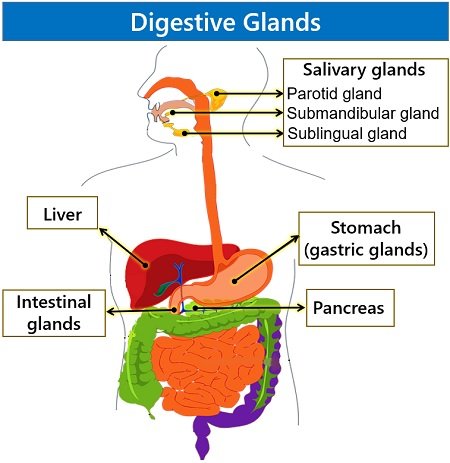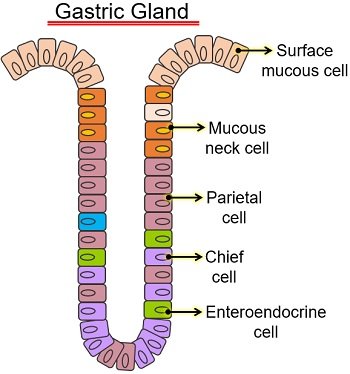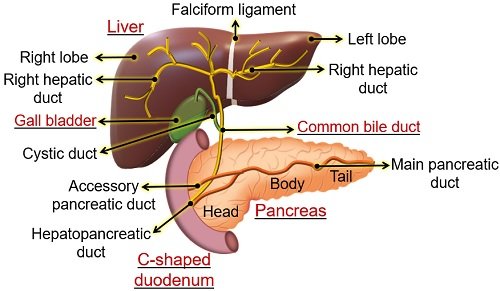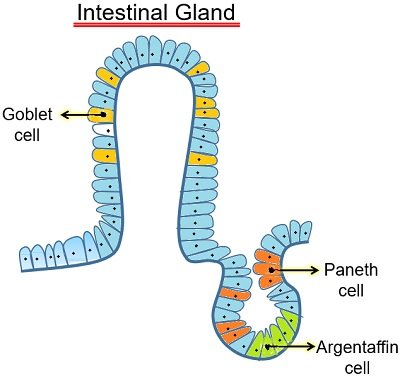Digestive Glands in Human Body
Digestive glands in the human body play an important role in food digestion. These are associated with the alimentary canal to aid the process of digestion.
The salivary gland, liver and pancreas are the accessory digestive glands. Gastric and intestinal glands are the digestive glands present in the lining of the stomach and small intestine.
Digestive glands are known for secreting digestive fluids into the alimentary canal. Digestive secretions contain digestive enzymes that ease digestion by breaking the complex food into digestible form.
Also, they contain a few hormones that regulate the cell metabolic pathways. Besides digestion and metabolism, digestive glands help the body’s tissues in absorbing food nutrients.
This post discusses the definition and types of digestive glands. Then, you will get to know the role of each digestive gland in the digestion process.
Content: Digestive Glands in Human Body
What are Digestive Glands?
They contribute to the physical and chemical breakdown of the ingested food by secreting some fluids. These fluids include saliva, bile secretions, pancreatic juices, gastric juices and intestinal juices.
Types of Digestive Glands in the Human Body

Glands contributing to the production of digestive juices are as follows:
- Salivary Glands are present in the mouth’s oral cavity. Salivary glands secrete saliva loaded with water, mucus, ions and enzymes. From the mouth, the mechanical digestion of food starts with the chewing action of teeth. First, teeth break large pieces into smaller pieces. Then, salivary amylase in the saliva chemically breaks starch into maltose.
- Gastric Glands are present in the stomach lining. It is the place from where the secretion of gastric juices occurs. Then, gastric juices partly break down the complex food into smaller ones. This leads to chyme production, which is the partly digested food incorporated with gastric juices.
- Liver is present beneath the diaphragm. The gallbladder and bile duct are adjuncts of the liver that contain no digestive enzymes. The liver secretes bile and the gallbladder stores bile juice. When chyme reaches the duodenum from the stomach, the liver releases bile. Bile being a surfactant emulsifies lipid globules into micelles or droplets.
- Pancreas releases pancreatic juices necessary for the proper digestion and assimilation of macronutrients. The pancreas releases pancreatic juices once chyme reaches the duodenum.
- Intestinal Glands are present in the intestine lining and secrete intestinal juices and mucus.
Secretions from salivary glands, gastric glands, and liver partially break down the food. But, our body can absorb nutrients after the complete breakdown of the food.
Here, the pancreas and intestinal glands come into action to complete food digestion. Pancreatic and intestinal juices are loaded with all the enzymes that can break large biomolecules.
Our body absorbs nutrients from the digested matter and releases the rest of the waste through the anus.
Salivary Glands
These are the exocrine glands that secrete saliva. Salivary glands lie outside the buccal cavity. There are two types of salivary glands based on the location within the oral cavity:
Minor Salivary Glands
These are smaller but found large in number (800-1000). Minor salivary glands lie in the oral submucosa and include:
- Labial and buccal glands are the glands of lips and cheeks. These act as mixed glands having mucous tubules with serous demilunes.
- Glossopalatine glands are purely mucous glands present in the isthmus.
- Palatine glands are mucous glands present on the soft palate of the mouth and around the uvula.
- Lingual glands are present underneath the tongue. Their anterior part is a mucous type, while the posterior part can be serous or mucous.
Major Salivary Glands
These are larger and produce most of the saliva. Humans have three types of major salivary glands.

- Parotid glands are the largest salivary glands. They are two in number, present in front of each ear. These produce 20 % of serous saliva.
- Submandibular or submaxillary glands appear smaller. A pair of submandibular glands is present behind the lower jaw. They produce 75% of mixed salivary secretions (both serous and mucous).
- Sublingual glands are the smallest. There are two sublingual glands present on either side of the tongue. They secrete 5 % of the mucous saliva.
Based on secretions, saliva glands can be serous, mucous, or mixed types.
- Serous saliva: It is an opalescent liquid that contains ions and enzymes.
- Seromucus or Mixed saliva: It is something like viscous saliva containing mucin, electrolytes, and enzymes.
- Mucous saliva: It is a thick, clear, slimy secretion containing no enzymes. Mucous saliva binds the masticated food into a bolus that slides down the oesophagus.
Saliva is a thick, opalescent liquid that contains water, mucus, proteins, electrolytes and enzymes. Serous and mucous cells are the secretory cells producing saliva. Thus, the whole saliva that moistens the oral cavity is a product of secretions from major and minor salivary glands.
Gastric Glands
These are present in the stomach lining and secrete gastric juices. A bolus from the alimentary canal reaches the stomach and mixes with gastric juices. The types of gastric glands in humans are as follows:
- Cardiac glands in the top part of the stomach secrete mucus.
- Oxyntic glands in the body of the stomach produce digestive substances.
- Pyloric glands in the lowest part of the stomach release mucus.
A gastric gland is composed of the following cells shown in the diagram.

1. Surface Mucus Cells and Neck Cells secrete bicarbonate and gastric mucus. Gastric mucus is a glycoprotein that performs two functions:
2. Parietal Cells: These produce hydrochloric acid and castle intrinsic factor.
- HCl production is necessary to activate digestive enzymes. HCl lowers the stomach’s pH to around 2. It also splits pepsinogen into pepsin.
- Intrinsic factor is necessary for the absorption of vitamin B-12 (a water-soluble vitamin).
3. Chief Cells: They secrete pepsinogen (precursor of pepsin) and gastric lipase.
- Pepsinogen turns into pepsin by the action of HCl. Pepsin hydrolyzes the tertiary and secondary protein polypeptides into smaller peptides.
- Gastric lipase is the digestive enzyme breaking down the short and medium-chain fats.
Liver
It is the largest exocrine gland with a weight of 1.5 Kg. The falciform ligament is between the right and left lobes of the liver. The liver has a pear-shaped pouch or gall bladder.
It is an exocrine gland because it contains hepatic ducts. Right and left hepatic ducts combine to form a common hepatic duct.

The cystic and common hepatic ducts combine to give a common bile duct. The liver and its adjuncts (gall bladder and bile duct) play an essential role in food digestion.
Pancreas
The pancreas exists as an elongated yellowish gland behind the stomach. It has a head, body and tail. The head of the pancreas is in touch with the curve of the duodenum.
The common bile duct and the main pancreatic duct form a hepatopancreatic duct. The sphincter of Boyden regulates the amount of bile secretion by the gall bladder.
The pancreas is a heterocrine or mixed gland that is both exocrine and endocrine in nature.
- The endocrine part consists of four cells (alpha, beta, delta and F-cells) that take part in the regulatory mechanisms.
- The exocrine part of the pancreas contains acini cells that produce pancreatic juices to break down foods. Thus, the exocrine part of the pancreas plays a vital role in digestion.
The pancreatic juices are alkaline due to the presence of bicarbonate ions. Duodenum secretes secretin and cholecystokinin hormones to regulate the secretion of pancreatic juices.
The accessory pancreatic duct allows the passage of pancreatic juices into the C-shaped duodenum. Pancreatic juices enter the duodenum passing the hepatopancreatic ampulla.
Each day, the pancreas produces 500-800 ml of pancreatic juices filled with bicarbonate ions, proenzymes and enzymes. Trypsinogen, chymotrypsinogen and procarboxypeptidase are the proenzymes or enzyme precursors. Enzymes in the pancreatic juices include lipase, protease, amylase etc.
Intestinal Glands

They are short and numerously present in the mucosa of the small intestine. Brunner’s Glands or duodenal glands are branched tubular glands that lie in the submucosa of the duodenum.
Crypts of Lieberkuhn are simple tubular glands that exist between the finger-like projections or villi of the small intestine. They secrete intestinal juices or succus entericus. Intestinal secretions are slightly alkaline (7.5 to 8.0 pH). Crypts of Lieberkuhn glands secrete about 2-3 litres of intestinal juice daily.
Functions of Digestive Glands
Digestive Glands play a major role in the food digestion which are discussed below:
Functions of Salivary Glands
Salivary glands secrete saliva that participates in the digestion process in the following ways:
- Saliva forms a food bolus via the chewing action of teeth and the rolling action of the tongue. So, it somehow participates in the mechanical digestion of food.
- Saliva contains salivary amylase or ptyalin that causes hydrolysis of starch into maltose.
- After mastication and amylase digestion, the food turns into a bolus. Salivary fluids moisten the mouth and ease the swallowing of a bolus down the oesophagus into the stomach.
- Also, mucous in the saliva lubricates a bolus and eases the passage of food through the alimentary canal.
Functions of Gastric Glands
Gastric glands are known for secreting gastric juices which perform the two major functions:
- It mediates the digestion of complex proteins into simpler forms.
- Mucus in the gastric juice lubricates food materials.
Functions of the Liver
The liver secretes bile and some regulatory hormones that also contribute to the digestion process.
- The liver secretes bile which plays a vital role in the emulsification of fats. Bile secretions are alkaline, with a pH of 8.4. It converts fat globules into micelles or droplets. Bile also increases peristaltic movement in the duodenum.
- The liver regulates carbohydrate metabolism through the endocrine function of alpha and beta cells in the pancreas.
- Converts excess glucose into glycogen via glycogenesis.
- Transforms stored glycogen into glucose via glycogenolysis.
- Converts non-carbohydrate substances into glucose throughgluconeogenesis.
Functions of Pancreas
The pancreas secretes pancreatic juices that contain the following digestive enzymes to degrade the complex molecules.
- Lipase and bile break down the fats that we intake. Less production of lipase causes poor absorption of lipids and fat-soluble vitamins (A, D, E, and K).
- Protease denatures proteins.
- Amylase splits starches into glucose.
Functions of Intestinal Glands
- Brunner’s glands secrete mucus. The mucus lubricates the digestive tract and the food so that food slips down into the small intestine. Also, the mucus protects the mucosa by neutralizing the stomach-derived acidic chyme.
- Crypts of Lieberkuhn secrete intestinal juices (a cocktail of enzymes that can digest all the forms of food materials). They contain aminopeptidases, intestinal amylase, maltase, isomaltase, dipeptidases, sucrase, and intestinal lipase. The goblet cells in the epithelium of such glands also secrete mucin.
Conclusion
Thus, digestive glands contribute to the digestion of food by secreting fluids. The salivary glands, liver and pancreas are the accessory digestive glands contributing to the mechanism of food digestion.
Whereas gastric glands in the stomach wall and intestinal glands in the intestinal wall are directly involved in the digestion process. All such glands take part in the mechanical and chemical digestion of food.
You Might Also Like: